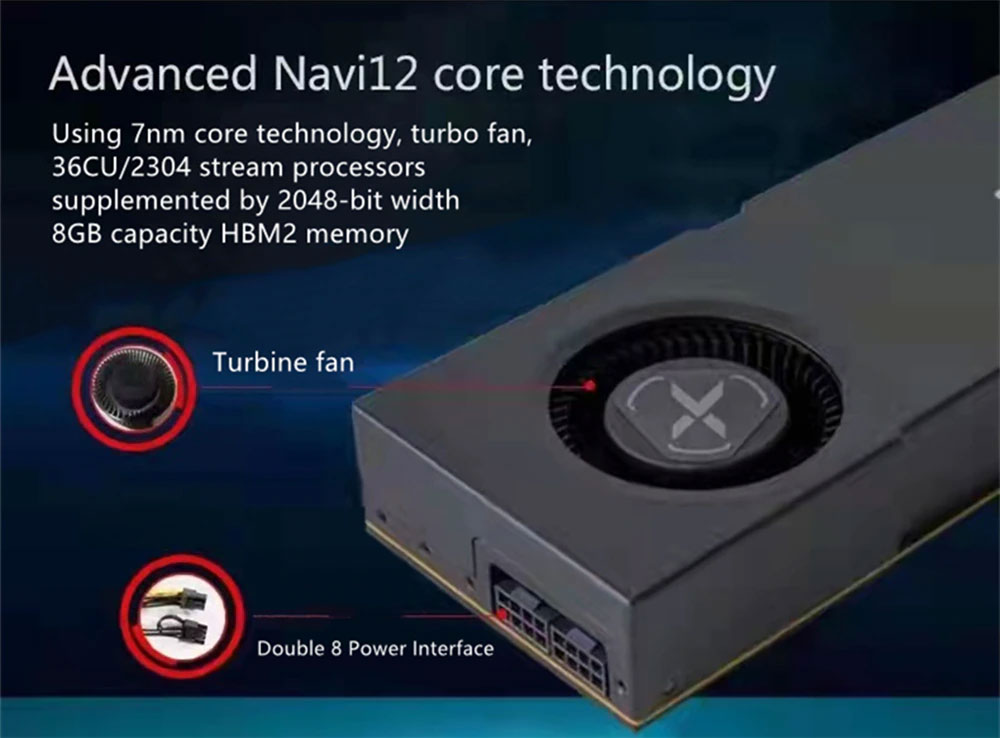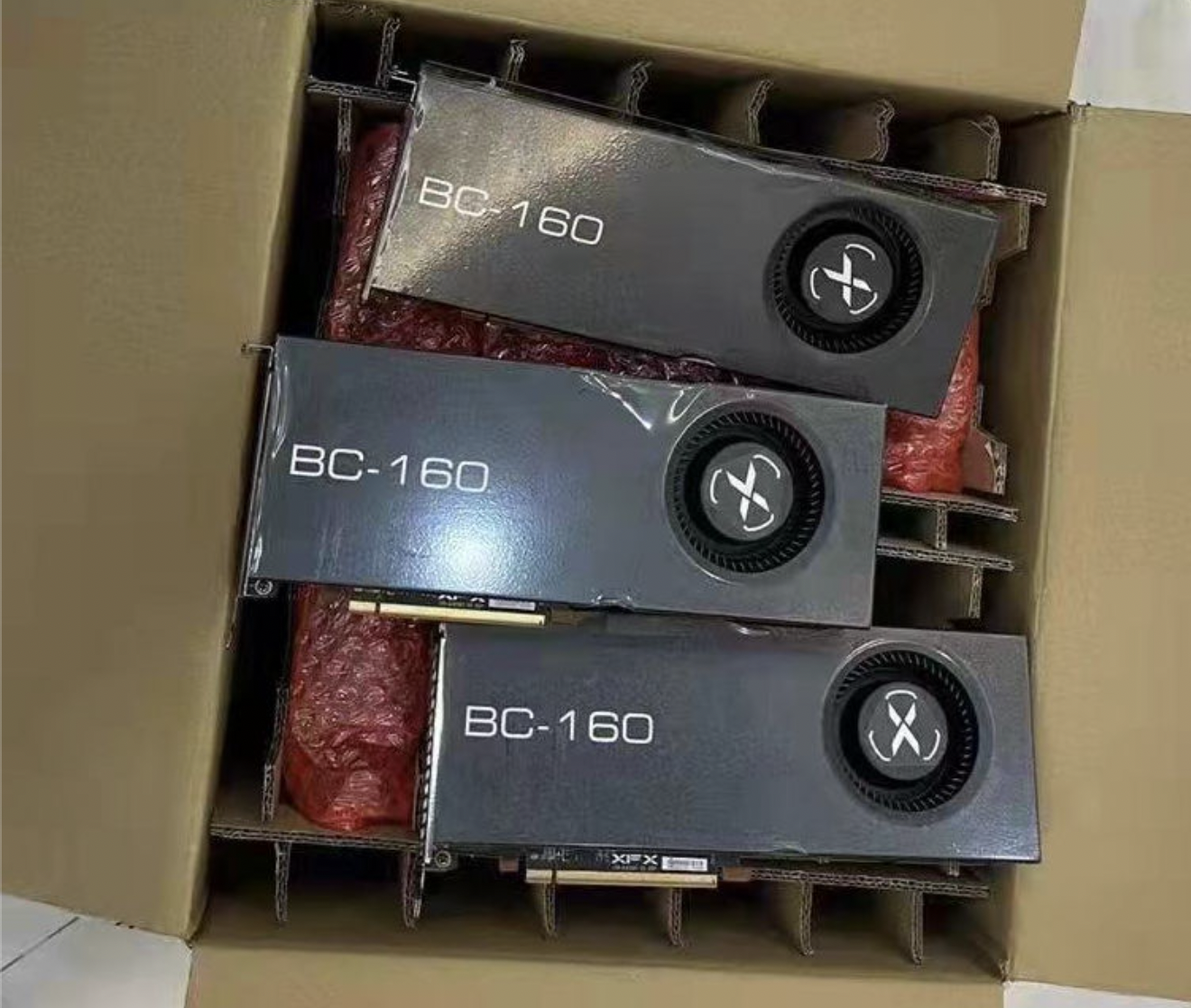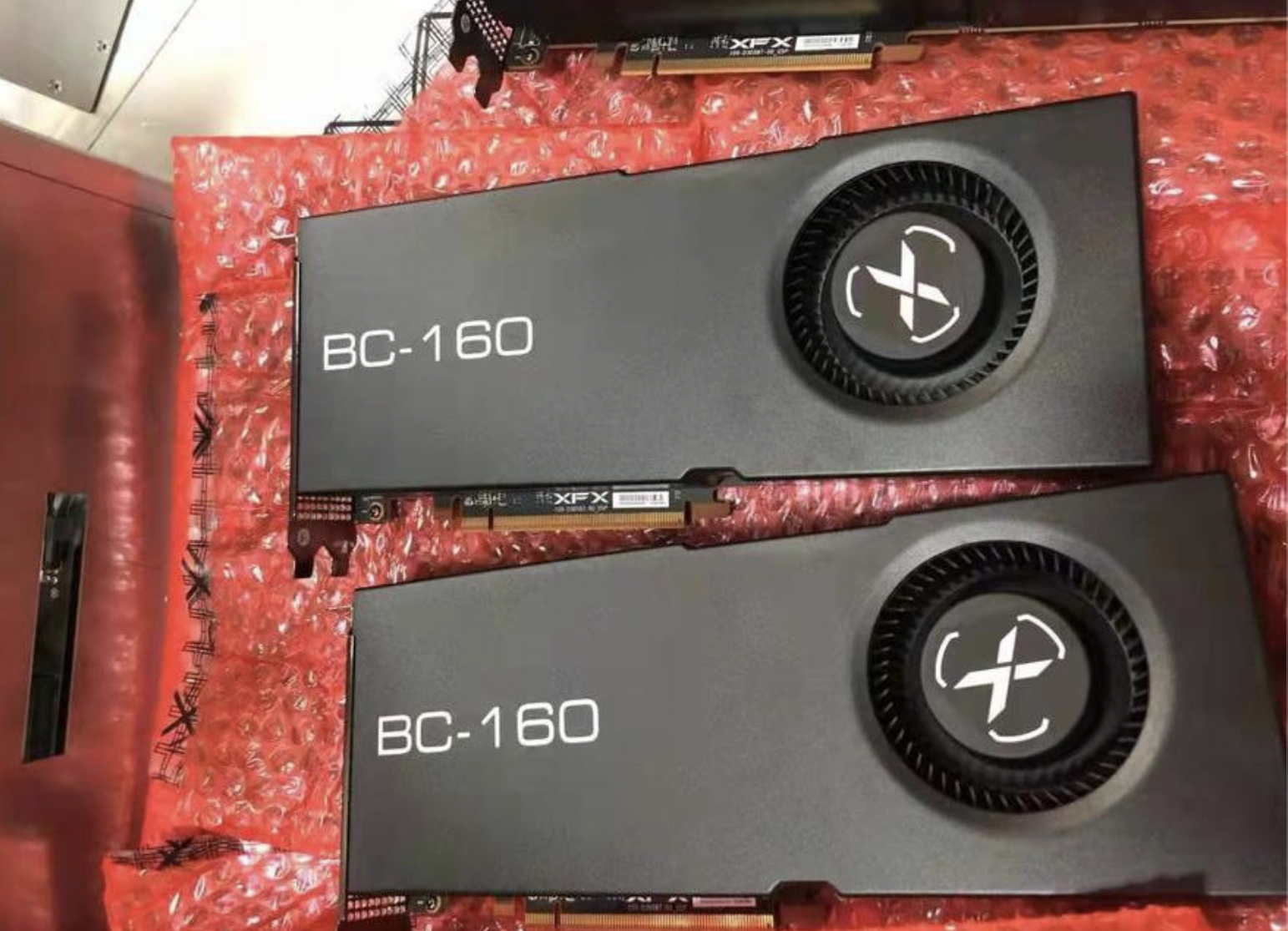AMD Navi 12 BC-160 Mining Cards on Sale in China
Another AMD partner is shipping mining cards based on the company's silicon, this time via Aliexpress. From the listing we seem to have an XFX graphics card designed for mining workloads. The new XFX BC-160 card makes use of Navi 12, manufactured on 7nm silicon and packing 2304 Stream Processors across 36 Compute Units. It employs 8GB of HBM2 memory running over a 2048-bit bus.
XFX's BC-160 features a straightforward naming scheme that's unlike any other AMD product. According to spec sheets and marketing materials for the cards, decoding the product code results in a Blockchain Compute (BC) card, in the first generation (1), offering up to 69.5 MH/s typical ETH mining performance (BC-160) in a 150W TGP envelope. This hash rate was achieved under the RedHat release of Linux, which we assume refers to RHEL (Red Hat Enterprise Linux) as Red Hat Linux was discontinued in 2004. The cards also claim compatibility with the Ubuntu distro.


There are a lot of interesting elements to this card. For one, the Navi 12 silicon was primarily used in one other AMD graphics product: the Radeon Pro 5600M for laptops, specifically Apple's MacBook Pro 16-inch model. It was also used in the Radeon Pro V520, though likely in far lower quantities, and that seems to be the basis for the BC-160 design. It's interesting that there are now apparently enough surplus chips that AMD is allowing partners to repurpose the GPUs for mining cards. Then again, with Apple shifting it's MacBook Pro line to its own M1 Pro and M1 Max, there's a good chance it has no real desire for additional AMD GPUs from 2020.
Another interesting point is that these XFX mining cards are powered by two 8-pin PEG connectors. Considering a single 8-pin connector can supply 150W of power, and the PCIe x16 slot can deliver another 75W, putting two connectors on the cards seems overkill. Again, these were chips originally used in laptops, where they were tuned to consume far less than 150W — 50W, to be precise. The AMD Radeon Pro V520 had a 225W TGP, though, and similar to the BC-160 it used a single blower-fan cooling design, which should be adequate for cooling the cards considering the workloads they're meant to handle. Ethereum mining strains VRAM more than anything, and the screenshots indicate power use of around 120W.
The use of HBM2 is part of the Navi 12 design, but at least on the MacBook Pro models it was clocked at a relatively low 1540 MT/s. Even with a 2048-bit bus, that's just 394 GBps of bandwidth, while the desktop 5700 XT GDDR6 models had a 256-bit interface and ran at 14 Gbps for 448 GBps of bandwidth. The screenshots show the BC-160 mining at "1275," which looks slower than the MacBook Pro model, but it's likely double that speed in MT/s, meaning 652.8 GBps of bandwidth after overclocking.
That would explain how the card manages 70 MH/s in Ethereum mining, where the RX 5700 XT after tuning tops out at around 55 MH/s. At stock, the HBM2 likely runs at the same 2000 MT/s as the AMD Radeon Pro V520, which would put the hashrate at the target 60 MH/s. On other words, the BC-160 delivers more bandwidth than the otherwise similar Navi 10 GPUs that used GDDR6.
Being a mining card, these are headless designs, so there's no display output. That means these cards are unfortunately only ever going to fulfil a singular purpose and will never be among the best graphics cards for gaming. They're pretty much solely designed for miners, potentially keeping said miners away from the gaming-oriented RX 6000 series. That's too bad, and it shows once more than the graphics card companies are more than happy to prioritize mining cards if that's where they can make the most money on sales.


XFX's BC-160 joins Sapphire's X080 and X060 "unofficial" mining cards. Looking at how the cards differ in their design, it seems safe to say that AMD isn't providing AIB partners with a reference, blockchain-compute oriented design. Instead, AMD's partners are the ones that are designing these cards around AMD silicon. AMD likely makes the same bottom-line earnings whether the GPUs end up in RX 6000-series, RX 5000-series, or cryptocurrency mining products. Unfortunately, that also means less stock for gaming-oriented cards, as both XFX's Navi 12 and Sapphire's Navi 22 mining cards both consume 7nm chips that could otherwise have gone into the gaming segment.
Based on the mining performance and power use, the BC-160 would likely rank well in our list of the best GPUs for mining. Its HBM2 memory subsystem does increase the price, however. Sapphire's best-performing X080 has an estimated price of around $850, while the new XFX BC-160 is listed on Aliexpress for a cool $2,000. That's more than it costs for an RTX 3080 Ti, using eBay GPU prices, which can do around 80 MH/s. A video of the XFX BC-160 cards in their mining environment (and the hashrate report, at 3:38) is also available, which you can see below.
Get Tom's Hardware's best news and in-depth reviews, straight to your inbox.

Francisco Pires is a freelance news writer for Tom's Hardware with a soft side for quantum computing.
-
ezst036 Could someone please get confirmation as to if defective GPUs are being re-purposed into a mining-only scenario? Earlier reports made this claim.Reply -
gargoylenest ok, so marketing strategy...sell mining cards in one of the only country where its illegal to mine?Reply -
daeros Not just the one use case - these could also work very nicely as desktop accelerators for a VDI server setup - those don't need to have local display outputs.Reply
I also like the jab at companies building products for the customers who will pay the most for them - that's their job. Where do you think they get the billions of capital? It comes from investors, and they expect a return on their money. Companies that intentionally make income-decreasing business decisions generally do not last long. -
thisisaname Reply
Yes was just think that too.gargoylenest said:ok, so marketing strategy...sell mining cards in one of the only country where its illegal to mine?
